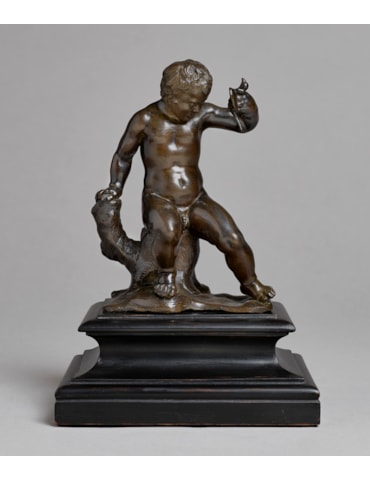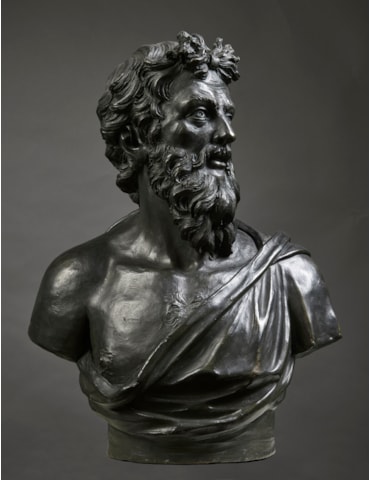Antonio Susini
Florence 1558 - 1624
A Peasant or Cowherd Resting on his Staff
Bronze statuette, after a model by Giambologna (1529-1608) of before 1601
Height: 12.6 cm / 5 in; including marble base: 22 cm / 8¾ in
Height: 12.6 cm / 5 in; including marble base: 22 cm / 8¾ in
ENQUIRIES
+44 (0)20 7259 0707
Provenance: Private Collection, Holland, since 1972
Some other known casts: Rome, Museo di Palazzo Venezia (inv. no. PV 10809), h. 13 cm;1 London, Christie’s, 1 July 1997, lot 48, h. 12.9 cm; London, collection of S. Franses, h. 12.7 cm;2 USA, private collection, h. 12.5 cm;3 Quentin Foundation, h. 12.7 cm;4 Cambridge, Fitzwilliam Museum (inv. no. M.2-1973), h. 12.3 cm;5 London, Sotheby’s 4 July 1996, lot 37, h. 12 cm; London, Sotheby’s, 8 December 1988, lot 107, h. 12 cm, a later variant with a pilgrim’s shell on the upturned brim of his hat; London, Victoria and Albert Museum (inv. no. A.19-1971), h. 11.5 cm, a late cast.6
In 1601 a silver version of the present composition was one of four silver statuettes loaned from the Galleria of the Uffizi to Antonio Susini (active from c.1580-1624), presumably for casting in bronze. The document described it as follows: “Una figuretta d’arg[ento] di un villano co[n] Capello co[n] bastoncino che sappoggia il su il bastone pesa onc. 11.23”.
The following item in this list, perhaps a pendant composition, was referred to simply as “un pastore”.7 In the inventory made of Benedetto Gondi’s collection in Florence on 4 November 1609, there is mention of “Un pastorino”, which this time is accompanied by a specific attribution to Giambologna: “Tre figure di bronzo, d’una Venere, d’un pastorino e d’una femminina ... Tutte dette opere sono di mano e l’originali del Cavaliere Giovan Bologna.”8
These early documentary references have led to the general acceptance of the Peasant Resting on his Staff and Bagpiper Seated as models created by Giambologna, rather than Pietro Tacca, as was proposed by Watson & Avery in 1973.9 It is however interesting to note that Adriaen de Vries depicts an image of the Cowherd Resting on his Staff in the background of a relief of Fortuna that he made in 1618-20 for the tomb of Count Ernst von Holstein-Schaumburg which is in the St Martini Church, Stadthagen.10
Avery’s suggestion that Giambologna’s Peasant Resting derives from a Roman marble statue now in the Galleria Colonna, Rome cannot for now be fully endorsed, as it is only first recorded in 1689.11 Both the Peasant Resting.... and Bagpiper Seated recall Giambologna’s Flemish origin and training, upon which he may also have drawn when asked to create many of the decorations for the gardens and grounds of Francesco de’ Medici’s villa at Pratolino in the late 1570s.12
1. A. Santangelo (ed.), Museo di Palazzo Venezia, Catalogo delle Sculture, Rome, 1954, p. 28, fig. XXXVII; A. Radcliffe & C. Avery, Giambologna 1529-1608 Sculptor to the Medici, exh. cat., Edinburgh & London, 1978, nos. 137-8.
2. A. Radcliffe in London 1978, p. 165, no. 138. 3. J. Auersperg, Daniel Katz. European Sculpture, New York, Simon Dickinson Inc., 4 – 15 May 1998, London, Daniel Katz Ltd, 8 June – 24 July 1998, pp. 48-49, no. 21, formerly An Exhibition of Old Master Drawings and European Works of Art [Trinity Fine Art Ltd], New York, Newhouse Galleries, 4 May – 18 May 1995, pp. 148-149, no. 82, the latter noting the provenance as Stirtloe House, Buckden, Cambridgeshire.
4. M. Leithe-Jasper and P. Wengraf, European Bronzes from the Quentin Collection, exh. cat., New York, Frick Collection, 28 September 2004 – 2 January 2005, pp. 158-161, no. 13.
5. V. Avery in V. Avery & J. Dillon, Renaissance and Baroque Bronzes from the Fitzwilliam Museum, Cambridge, exh. cat., London, Daniel Katz Ltd, 11 June – 19 July 2002, p. 307, no. 5 described as “Italian (Florence), early 17th century, after a model by Giambologna”.
6. This model and other known casts of it, including the present example, are discussed in more detail by P. Wengraf in Leithe-Jasper & Wengraf 2004, pp. 158-161, no. 13.
7. See London 1978, nos. 137-8 and for models of Hercules by Giambologna cast in silver 1576-89, see A. Radcliffe, The Robert H. Smith Collection. Bronzes 1500-1650, London, 1994, no. 17.
8. G. Corti, “Two early seventeenth-century inventories involving Giambologna”, The Burlington Magazine, vol CXVIII, September 1976, p. 632.
9. K. Watson & C. Avery, “Medici and Stuart: a Grand Ducal gift of ‘Giovanni Bologna’ Bronzes for Henry Prince of Wales (1612)”, The Burlington Magazine, vol. CXV, August 1973, pp. 493-507.
10. P. Wengraf in Leithe-Jasper & Wengraf 2004, pp. 160 & 161 fig. 1 & n.12.
11. C. Avery, Giambologna, 1987, p. 47 & nos 110-11. The history of the Roman marble Peasant resting is outlined in F. Carinci et al. (ed.), Catalogo della Galleria Colonna in Roma. Sculture, (Collezione Colonna in Roma), Busto Arsizio, 1990, pp. 109-110, no. 57.
12. E. Dhanens, “Jean Boulogne. Giovanni Bologna Fiammingo, Douai 1529 – Florence 1608. Bijdrage tot de studie van de kunstbetrekkingen tussen het graafschap Vlaandereden en Italie”, Verhandelingen. Koninklijke Vlaamse Academie voor Wetenschappen, Letteren en Schone Kunsten van België. Klasse der Schone Kunsten, II, 1956. pp. 224-9.
Some other known casts: Rome, Museo di Palazzo Venezia (inv. no. PV 10809), h. 13 cm;1 London, Christie’s, 1 July 1997, lot 48, h. 12.9 cm; London, collection of S. Franses, h. 12.7 cm;2 USA, private collection, h. 12.5 cm;3 Quentin Foundation, h. 12.7 cm;4 Cambridge, Fitzwilliam Museum (inv. no. M.2-1973), h. 12.3 cm;5 London, Sotheby’s 4 July 1996, lot 37, h. 12 cm; London, Sotheby’s, 8 December 1988, lot 107, h. 12 cm, a later variant with a pilgrim’s shell on the upturned brim of his hat; London, Victoria and Albert Museum (inv. no. A.19-1971), h. 11.5 cm, a late cast.6
In 1601 a silver version of the present composition was one of four silver statuettes loaned from the Galleria of the Uffizi to Antonio Susini (active from c.1580-1624), presumably for casting in bronze. The document described it as follows: “Una figuretta d’arg[ento] di un villano co[n] Capello co[n] bastoncino che sappoggia il su il bastone pesa onc. 11.23”.
The following item in this list, perhaps a pendant composition, was referred to simply as “un pastore”.7 In the inventory made of Benedetto Gondi’s collection in Florence on 4 November 1609, there is mention of “Un pastorino”, which this time is accompanied by a specific attribution to Giambologna: “Tre figure di bronzo, d’una Venere, d’un pastorino e d’una femminina ... Tutte dette opere sono di mano e l’originali del Cavaliere Giovan Bologna.”8
These early documentary references have led to the general acceptance of the Peasant Resting on his Staff and Bagpiper Seated as models created by Giambologna, rather than Pietro Tacca, as was proposed by Watson & Avery in 1973.9 It is however interesting to note that Adriaen de Vries depicts an image of the Cowherd Resting on his Staff in the background of a relief of Fortuna that he made in 1618-20 for the tomb of Count Ernst von Holstein-Schaumburg which is in the St Martini Church, Stadthagen.10
Avery’s suggestion that Giambologna’s Peasant Resting derives from a Roman marble statue now in the Galleria Colonna, Rome cannot for now be fully endorsed, as it is only first recorded in 1689.11 Both the Peasant Resting.... and Bagpiper Seated recall Giambologna’s Flemish origin and training, upon which he may also have drawn when asked to create many of the decorations for the gardens and grounds of Francesco de’ Medici’s villa at Pratolino in the late 1570s.12
1. A. Santangelo (ed.), Museo di Palazzo Venezia, Catalogo delle Sculture, Rome, 1954, p. 28, fig. XXXVII; A. Radcliffe & C. Avery, Giambologna 1529-1608 Sculptor to the Medici, exh. cat., Edinburgh & London, 1978, nos. 137-8.
2. A. Radcliffe in London 1978, p. 165, no. 138. 3. J. Auersperg, Daniel Katz. European Sculpture, New York, Simon Dickinson Inc., 4 – 15 May 1998, London, Daniel Katz Ltd, 8 June – 24 July 1998, pp. 48-49, no. 21, formerly An Exhibition of Old Master Drawings and European Works of Art [Trinity Fine Art Ltd], New York, Newhouse Galleries, 4 May – 18 May 1995, pp. 148-149, no. 82, the latter noting the provenance as Stirtloe House, Buckden, Cambridgeshire.
4. M. Leithe-Jasper and P. Wengraf, European Bronzes from the Quentin Collection, exh. cat., New York, Frick Collection, 28 September 2004 – 2 January 2005, pp. 158-161, no. 13.
5. V. Avery in V. Avery & J. Dillon, Renaissance and Baroque Bronzes from the Fitzwilliam Museum, Cambridge, exh. cat., London, Daniel Katz Ltd, 11 June – 19 July 2002, p. 307, no. 5 described as “Italian (Florence), early 17th century, after a model by Giambologna”.
6. This model and other known casts of it, including the present example, are discussed in more detail by P. Wengraf in Leithe-Jasper & Wengraf 2004, pp. 158-161, no. 13.
7. See London 1978, nos. 137-8 and for models of Hercules by Giambologna cast in silver 1576-89, see A. Radcliffe, The Robert H. Smith Collection. Bronzes 1500-1650, London, 1994, no. 17.
8. G. Corti, “Two early seventeenth-century inventories involving Giambologna”, The Burlington Magazine, vol CXVIII, September 1976, p. 632.
9. K. Watson & C. Avery, “Medici and Stuart: a Grand Ducal gift of ‘Giovanni Bologna’ Bronzes for Henry Prince of Wales (1612)”, The Burlington Magazine, vol. CXV, August 1973, pp. 493-507.
10. P. Wengraf in Leithe-Jasper & Wengraf 2004, pp. 160 & 161 fig. 1 & n.12.
11. C. Avery, Giambologna, 1987, p. 47 & nos 110-11. The history of the Roman marble Peasant resting is outlined in F. Carinci et al. (ed.), Catalogo della Galleria Colonna in Roma. Sculture, (Collezione Colonna in Roma), Busto Arsizio, 1990, pp. 109-110, no. 57.
12. E. Dhanens, “Jean Boulogne. Giovanni Bologna Fiammingo, Douai 1529 – Florence 1608. Bijdrage tot de studie van de kunstbetrekkingen tussen het graafschap Vlaandereden en Italie”, Verhandelingen. Koninklijke Vlaamse Academie voor Wetenschappen, Letteren en Schone Kunsten van België. Klasse der Schone Kunsten, II, 1956. pp. 224-9.





